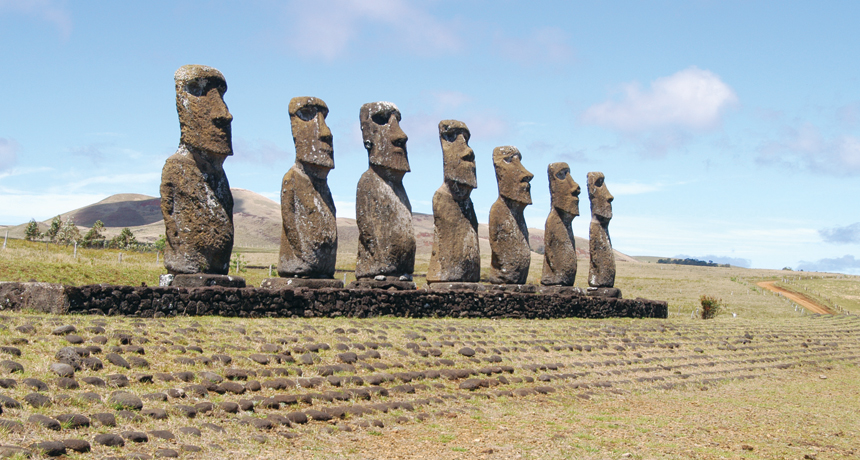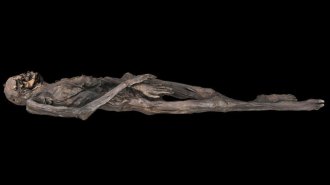Easter Island’s farmers cultivated social resilience, not collapse
Polynesian society thrived despite having created environmental challenges

COLLAPSE-PROOF New evidence supports the argument that makers of huge stone sculptures on Easter Island weathered environmental challenges rather than succumbing to them.
Bishop Museum
Easter Island’s Polynesian society is known for having created huge, humanlike statues and for supposedly folding in the late 1600s after overexploiting limited land. But that proposed societal collapse may never have happened, a new study suggests.
Despite largely clearing the island of its palm forest by roughly 1550, groups on Easter Island, also known as Rapa Nui, contained enough people to farm coastal and inland sites until well after Europeans first arrived in 1722, says anthropologist Mara Mulrooney of the Bernice Pauahi Bishop Museum in Honolulu.
“Deforestation did not equal societal failure on Rapa Nui,” Mulrooney says. “We should celebrate the remarkable achievements of this island civilization.”
Mulrooney’s analysis of 313 radiocarbon dates from structures and settlements across Rapa Nui appears in the December Journal of Archaeological Science.
Starting at least years ago, archaeologists proposed that slash-and-burn agriculture wiped out palm forests and robbed the soil of nutrients, and the depletion of natural resources triggered a social implosion on Rapa Nui before Europeans arrived. Geographer Jared Diamond of UCLA popularized that scenario in his 2005 book Collapse.
Mulrooney’s investigation, which includes 15 new radiocarbon dates from 11 excavations in a northern section of Rapa Nui, suggests that farmers successfully adapted to the loss of the island’s trees. It wasn’t until around the time of Captain Cook’s 1774 visit to Rapa Nui that signs of population decline — indicated by a decrease in the number of radiocarbon dates, especially at inland sites — appeared, perhaps due to infectious diseases introduced by the Europeans, she suggests.Studies conducted by other researchers on Rapa Nui over the last two decades indicate that as the palm forest shrank, island farmers increasingly cultivated gardens of yams, sweet potatoes, taro and other crops in enclosures with stones and boulders strategically placed on the soil. These rocks protected plants from wind, prevented evaporation of rainwater, deterred weed growth and boosted soil nutrients. Mulrooney thinks that this tactic allowed the island society to thrive and sustain different social classes, including artisans who carved giant sculptures, after the palm forest had been destroyed.
Mulrooney doesn’t firmly demonstrate that the radiocarbon dates she sampled track relative population changes over time, comments archaeologist Carl Lipo of California State University, Long Beach. But in his view the new paper joins emerging lines of evidence suggesting that islanders worked around environmental challenges to achieve cultural greatness.
“The idea of societal collapse on Rapa Nui has long been assumed, but there is no scientific basis for it,” Lipo says.
Editor’s Note: This story was updated January 6, 2014, to correct how long ago it was that archaeologists first proposed that Rapa Nui’s agriculture triggered population collapse.







